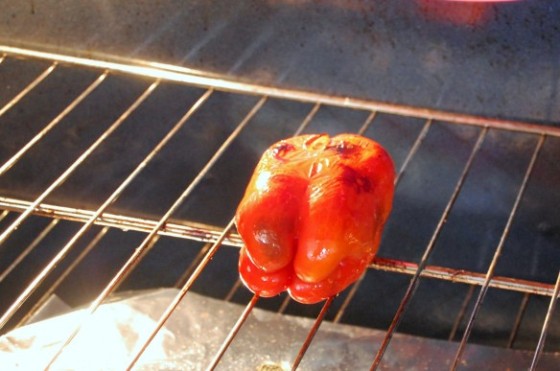
Well, my friends, the weekend is upon us. It’s finally Friday and I know what I’m doing when I get home – pouring myself a cocktail. Is there really any better way to unwind after a stressful week than with a cocktail? I love me a good cocktail – and when it comes to cocktails, I’m a vodka girl. I don’t want your tequila, or your rum, or your fancy-pants wine – just give me a little vodka and a little juice and send me on my merry little way.
So what’s a finnicky girl like me to do to spice up her cocktails while not spending a ton of money on flavored vodkas? Flavor her own, of course! There is no better time to make your own vodka than in the summer, when berry season is in full-swing and you’ve got more berries than you know what to do with.

Hopefully this summer’s posts will serve me well next year in remembering to not buy every container of berries that I walk by (I bought two more containers of strawberries yesterday – but it was such a good deal!)… I need to go to berryholics anonymous… it’ll be OK, though. My strawberry vodka reserves are getting low anyway, so it’s about time to infuse some more… 😉
The great thing about berry vodkas is that, while they recommend to let them sit for quite a while, once the berries have lost their color they’ve lost most of their flavor as well. So even though I might leave them in there for a couple weeks, after the first few days my vodka is already rich with the color and flavor of whatever berries I happen to be infusing. Mix a bit with some lemonade and you’ve got yourself a berry lemonade cocktail, add a splash of fizz if you’re feelin’ sparkly
How to Infuse Your Own Vodka (or other liquor):
- Berries, washed and diced
- Vodka (or other liquor – make sure it’s relatively neutral in flavor)
1. Fill your container about 1/3 with washed berries of your choice
2. Fill it the rest of the way with liquor
3. Set in a cool place (we use our fridge, because “room temp” at our house is like 78 degrees).
4. Shake it around once in a while
Some things to know…
* The smaller you chop your fruit (like strawberries, pineapple, or melon), the faster your liquor will infuse. Blueberries don’t need to be chopped, but you will probably want to score them with a knife (or just smoosh them a little). Blackberries and things of that nature are probably OK to stay whole. With citrus, it’s best to just use the rind, but make sure you don’t get any of the pith with it!
* Shake your container every once in a while to mix it up a bit.
* Once your liquor has infused, strain out your fruit for permanent storage.
* If you want to make a “liquer” instead of “liquor” – after you remove your berries add some simple syrup.
* Since I like to re-use things, I re-use washed grapefruit jars, which causes my BF to make fun of me for making “moonshine”… just be forewarned that if you use a jar someone may make fun of you and call it “moonshine”. If this happens, tell them to “shut it” and promptly make yourself a cocktail. 🙂
* I usually try to let them infuse for about a week or two, but I’ve been known to make a drink after just a few days of infusion after an especially rough day. So long as there is a good amount of color in the vodka, you should be ok.
* DO NOT try to eat the fruit, all of its flavor is now in the liquor. This isn’t sangria, people.
*You can find bottles for very cheap at The Container Store or Sur la Table
 Ah yes, ye olde bell pepper. This post may seem a little random at the moment, but this skill is necessary to complete my next post. So today, I give you a tutorial on how to roast red peppers. Don’t worry, it’s easy 🙂
Ah yes, ye olde bell pepper. This post may seem a little random at the moment, but this skill is necessary to complete my next post. So today, I give you a tutorial on how to roast red peppers. Don’t worry, it’s easy 🙂 Take one (or more) beautiful red pepper(s) (or whatever kind of pepper you wish to use). Washed and patted dry. Then, rub said pepper with oil. I used olive oil. Place this now oiled pepper into your oven or onto your grill and cook until the skin starts to blister and char, rotating as necessary until all sides are done.
Take one (or more) beautiful red pepper(s) (or whatever kind of pepper you wish to use). Washed and patted dry. Then, rub said pepper with oil. I used olive oil. Place this now oiled pepper into your oven or onto your grill and cook until the skin starts to blister and char, rotating as necessary until all sides are done. Remove the pepper and place in a bowl. Cover with plastic wrap and allow to rest 15 minutes or until cool enough to handle. Once cooled, uncover and peel the skin off. Don’t worry, it’ll come right off. Slice or dice into desired pieces and, Voila – you now have roasted peppers!
Remove the pepper and place in a bowl. Cover with plastic wrap and allow to rest 15 minutes or until cool enough to handle. Once cooled, uncover and peel the skin off. Don’t worry, it’ll come right off. Slice or dice into desired pieces and, Voila – you now have roasted peppers!









